#I like how it’s inverse what she wears during the route story
Explore tagged Tumblr posts
Photo
Is it weird I think about this a lot? Even after how many years later??
😂
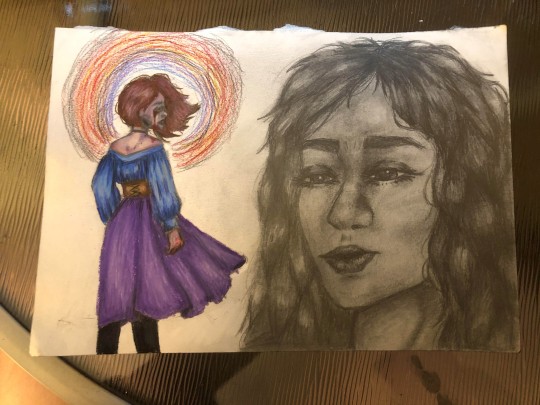
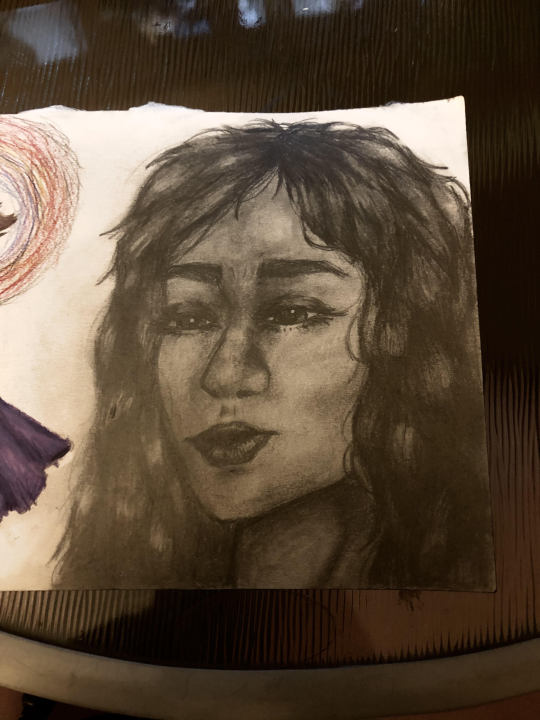
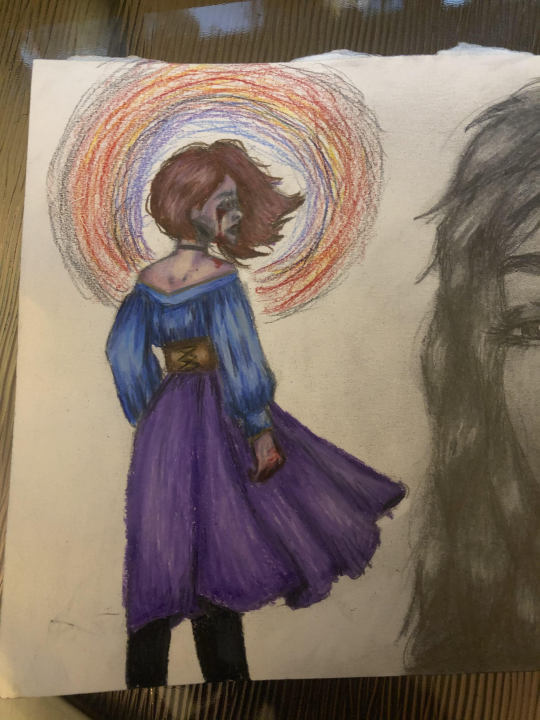
I decided to draw a scene from @madllamamomma ‘s Story “Journey Back To the South” (with a bit of embelishment),when Rhemi has a dream of her old self infront of a burning manor. The black and white is her trying to make sense of the figure she saw, and the figure is the figure on the left. I’ll try to recolor this digitally when I have my apple pencil back :,).
(Also I started coloring this before the real design of the old Rem was posted so :,( it’s not the correct outfit, but even despite that I hope you like it!)
{ thanks to my horrible Iphone 8 and tumblr for the absolutely terrible quality of this image <3}
#I love this outfit not gonna lie#kinda think it’s gonna be what she wears when she dies#I like how it’s inverse what she wears during the route story#may redraw it sometime?#but it’s already good#sooooooo#😂#literally as I am writing rn I think of this because it captures her creepiness and yet sadness#arcana muriel#arcana mc#rhemi the apprentice#thank you again for drawing this#the arcana#the arcana game#❤️❤️❤️
31 notes
·
View notes
Note
A couple hours late but I just saw you saying how Jesse and Fareeha are more inverses of each other and I completely agree! I personally see Sombra and Jesse as more paralleled, and would be interested in hearing your thoughts on that idea? You tend to be very well-spoken and are good at analyzing concepts, I've come to notice.
EDIT - NOVEMBER 3, 2018: With the release of “Reunion” and Ashe’s hero reveal, the majority of what I wrote about Deadlock in the first three sections—Sign of the Skull, Those Left Behind, Revolutionaries and Rebels—is incorrect. Despite this, I maintain that the socioeconomic context outlines in Those Left Behind remains relevant to the American Southwest in-universe and maintain my belief that it is applicable to McCree specifically, even if it does not apply to Deadlock. I will be writing a new post on Sombra and McCree soon. Stay tuned.
in reference to this post… from months ago
Lucky for you, I was thinking about Jesse and Sombra the night before you sent this! Deadlock and Los Muertos, actually, but I’ll get to that. I absolutely agree that the two of them make much more direct parallels than Jesse and Fareeha, who are interesting as a pair in their own right but they aren’t direct parallels.
I often joke that Gabe adopted the same child twice: smart-talking, hyper-competent Latine who tote around skull logos and are from gangs with the word “dead” in their names. It’s a joke—I don’t consider Gabe’s relationship with Sombra to be that of a parent-child, for one thing—but I believe that Jesse and Sombra are very similar regardless.
They both have similar backgrounds: joined local gangs at a very young age and earned later membership into a high-level covert organization through resourcefulness and an admirable natural aptitude in a specific desired skillset. Although both at first look to be unserious and overly laid-back, they prove themselves to be precision operators who indeed execute plans and achieve goals with immense gravity. They’re both supremely confident in their abilities, to the point that one can accuse them of having too high an opinion of themselves and being overconfident.
They come from similar backgrounds, having been orphaned during the Crisis and suffered under economic disparity driven by infrastructure changes in the rebuilding period. They both similarly drop off the map and resurface under new identities. They both have a deep concern in seeing done a justice that is beyond the reach of the law—or when the law refuses to deliver it.
All this, and more, under the cut. The post is very long.
I would also like to thank @segadores-y-soldados for all he’s written, especially on Sombra and especially recently. I make heavy reference to his writing on Sombra in certain portions of this post. I also must admit that reading his posts on Arturito has motivated me to finish this after three months of slow progress, though I still have a nagging feeling I’m forgetting a point.
Sign of the Skull
To make a quick run-through on Los Muertos and Deadlock Gang themselves before moving onto how these organizations inform Sombra and Jesse specifically. Sort of a section to outline basic things about the gangs that doesn’t neatly fit into other points. It’s mostly to establish their context, and some similarities between their structures and presentation.

Screenshot from the Sombra Origin showing members of Los Muertos. Each member has painted skeletons onto themselves with phosphorescent paint in varying colors.
Los Muertos is a Mexican gang with apparent regional influence with members in both Dorado and the nearby Castillo, and it even has some international reach judging from the Los Muertos graffiti on the Hollywood map. Little is known to us about their structure besides this, and even in-universe they are noted to be mysterious with little information publicly available about them.
However, Los Muertos openly broadcasts their intentions: to right the wrongs committed by the wealthy and powerful against the disadvantaged of Mexico. They position themselves as transgressors of the law specifically to disrupt the lives of the “vipers” in power. More on that later.
The name translates to “The Dead”, and they are identified by skull motifs, specifically the calaveras associated with the Mexican holiday Day of the Dead. Individual members openly identify themselves and indicate their membership by painting skulls and bones on their bodies with phosphorescent paint.
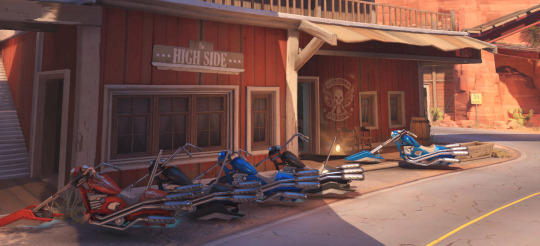
Screenshot from the Route 66 map of five motorcycles parked in front of The High Side bar. The Deadlock emblem is spray-painted by the entrance.
Deadlock Gang is an American motorcycle club and organized crime ring occupying a Southwestern town on an abandoned stretch of Route 66 running across Deadlock Gorge. It’s unclear where exactly the Gorge is, and the Visual Source Book’s pin for the map is highly unspecific, but I tend to believe it’s in somewhere in northern New Mexico because Jesse’s base of operations is listed as Santa Fe, NM.
In one lore piece, Deadlock is holding a national rally, suggesting they’ve got chapters nationwide and the founding chapter is in Deadlock Gorge. While it’s unclear what their reach is, there is a possibility of international chapters. (Torbjorn’s motorcycle-themed Deadlock skin may suggest this, but it does not have any Deadlock iconography, notably showing a bear where one expects the Deadlock emblem.)
This does not necessarily mean all of the Deadlock Rebels Motorcycle Club is a criminal organization, nor every single member a criminal, but… y’know, the founding chapter is a weapons trafficking racket. They’re a one-percenter outlaw motorcycle club, and there’s a quick and easy comparison in the real-life Hells Angels, whom the show Sons of Anarchy models itself after.
Deadlock, besides naming itself after the concept of death like Los Muertos does, also uses a skull in its emblem. We haven’t seen any member of Deadlock pictured, but extrapolating from the typical behavior of motorcycle clubs, they likely openly identify themselves and indicate their membership by wearing standardized jackets or most likely vests. Members likely have tattoos indicating membership as well, seeing as Jesse has a tattoo of the Deadlock emblem on his inner arm in his Blackwatch skin.
Those Left Behind
Sombra, orphaned during the Omnic Crisis, was taken in by Los Muertos, a gang that positioned themselves as champions of the underclass ignored during the post-Crisis rebuilding process. They’ve done this most notably by opposing the CEO of LumériCo Guillermo Portero, who they’ve described as having exercised his social influence to have many wrongfully imprisoned and who we know is working with the not-as-noble-as-they-put-forward Vishkar.
The social context of Los Muertos and Sombra is very directly told to us. From Sombra’s official bio:
After ░░░░░░ was taken in by Mexico’s Los Muertos gang, she aided it in its self-styled revolution against the government. Los Muertos believed that the rebuilding of Mexico had primarily benefited the rich and the influential, leaving behind those who were most in need of assistance.
From a lore post published to the website:
…its members style themselves as revolutionaries who represent those left behind by the government after the widespread devastation of the Omnic Crisis.
And Michael Chu on Los Muertos at Blizzcon 2016 (transcript):
Mexico really suffered a lot at the hands of the Omnic Crisis. The war destroyed much of the country’s infrastructure. […] They claim to be kind of revolutionaries fighting for people who were left behind during the rebuilding of Mexico after the war.
Despite their noble stated goal, they seemingly also cross a line in their illicit activity enough to earn the ire of Jack, who isn’t exactly on the straight and narrow himself but still seeks the right side of things. As Chu added:
Whether or not that’s really what they are up to, because they’re also engaged in a lot of other shady activities. It is up to you decide.
Given a lot of other suspect activity they engage in, that noble work might not be the only story to be had on them—especially depending on where you’re standing. Saviors with their thumbs in certain pies not meant for them, possibly.
The social context that Sombra rises out of is made very plain for us. But what does it have to do with Jesse?
While we know few specifics about his circumstances growing up, other than he also lived through the Crisis and was likely similarly orphaned during it, the description and in-game environment of the Route 66 map suggest the area is one of difficult social and economic circumstances, emphasis mine:
Though the travelers and road trippers who used to cross the US on historic Route 66 are gone, the Main Street of America still stands, a testament to a simpler time. The gas stations, roadside shops, and cafes have gone into disuse, and the fabled Deadlock Gorge is mostly seen from the comfort of transcontinental train cars. But amid the fading monuments of that earlier era, the outlaws of the Deadlock Gang are planning their biggest heist yet.
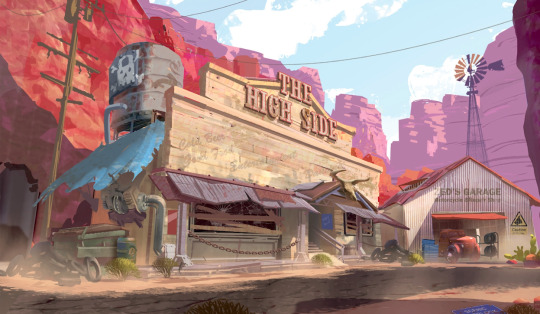
Concept art of The High Side, showing the abandoned bar in disrepair with boarded windows and faded paint.
At least one building, the Cave Inn (ba dum tsh) in the streets portion of the map, is visibly abandoned, and the theme of disrepair and long-gone halcyon days is especially prevalent in the concept art for the map. This all paints a portrait of a Deadlock Gang that operates out of an area that suffered immense economic hardship in recent years, likely particularly after the introduction of the transcontinental train cars, one of which is featured in “Train Hopper”, a comic which takes the time to emphasize the wealth of the passengers traveling on them. So, the Deadlock chapter is localized within a region that suffered economically under infrastructure changes that largely benefit the wealthy and powerful. It’s possible that these infrastructure changes were made possible because of efforts to rebuild after the physical devastation of the Crisis.
Without going off on a tangent about it, there’s a bit of a difference between “Deadlock comes out of the lower class in a geographic region beset by poverty” and “Deadlock gang itself currently has no money”. Apparently, well after the effects of financial misfortune set in, Deadlock was and is making enough money to maintain long-distance shipping, as suggested by their semi-trailer truck, and keep an entire town functioning well enough as a cover for their criminal enterprise. Also, missiles don’t sell for cheap. Deadlock might be financially comfortable now, but their context still involves deep socioeconomic disparity.
This is especially poignant against the Route’s invoked nickname, Main Street of America, which conjures images of the average American person. Those average people who owned gas stations, cafes, diners, roadside trinket shops, dive bars are the ones who are forgotten while the more affluent folks pass them over, traveling in style. There’s also a historical precedent in poverty and social disparity as driven by infrastructure changes specifically affecting the way people travel across regions and the country, specifically in the history of the freeway.
To sort of make the clarification, Jesse’s tattoo states that Deadlock was established in 1976—happy centennial, Deadlock—so they’ve certainly changed a lot as their social context and membership make-up changed. There’s much to be said about social non-conformity, outlaw motorcycle gangs, one-percenters, community integration, and how these intersect with both the politics and economics of the local communities along Route 66, especially given how the Route was recently listed as one of the country’s most endangered historic places, even in Deadlock’s apparent founding in a period of American social unease after the Vietnam War and during the late Cold War, and extrapolate a lot about Deadlock from all that, and even about Jesse himself from some of it, but that’s for a different post.
Revolutionaries and Rebels
In that context, it’s worthwhile to note that in their insignia, seen in the graffiti all over the Route 66 map and in Jesse’s tattoo in his Blackwatch skin, they calls themselves the Deadlock Rebels. Generally, outlaw motorcycle clubs are also known for their contempt for social convention and disdain for status quo.
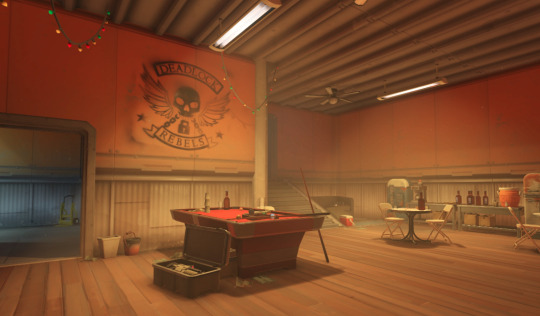
Screenshot of the Deadlock Gang hideout with their insignia, which includes the words Deadlock Rebels, spray-painted onto a wall.
Deadlock is quite the opposite of Los Muertos, though. Deadlock maintains a law-abiding public face—holding innocuous and even advertised national rallies and hiding their illicit activity under numerous cover businesses—and are more discreet in their disrespect of law. One can double down on this by looking to how successfully real-life one-percenter clubs maintain their public image: openly contemptuous of social norms but keeping public knowledge of any legal transgressions to only the small indiscretions while hiding the major ones.
Taking a look at Deadlock’s primary targets, military installations: the train cars on the map are military-related, the gang traffics military hardware and weapons including missiles. Although Deadlock comes from a similar social context as Los Muertos, these aren’t targets seeking to effect a change in society like how Los Muertos seeks to. Deadlock appears largely self-interested, with little interest in changing the fortunes of anyone else in the American lower class. Los Muertos bills itself as other-interested, seeking to change the fortunes of the Mexican underclass as a whole.
Archetypically, Los Muertos are revolutionaries, Deadlock are rebels. While they both groups reject the status quo, the revolutionary seeks sweeping social change but the rebel rejects the status quo on a personal level. The revolutionary wants society to change to suit their vision of what it ought to be while the rebel positions themselves outside of society and will redefine themselves as society changes.
The difference is apparent in their choice of targets. Los Muertos targets institutions and people who directly have a hand in the building of their social context, and attacking those targets will potentially affect a social change. Deadlock targets institutions and people who may have a hand in their social context, but such targets are chosen primarily for the gang’s financial gain.
Los Muertos is politically motivated. Deadlock is financially motivated.
Admirers in the Shadows
Sombra and Jesse don’t remain in their gangs. They both end up joining shadow organizations with global reach, the terrorist organization Talon and the covert ops organization Blackwatch, respectively. Both organizations were wooed by their specific skillsets.
Sombra launched an even more audacious string of hacks, and her exploits earned her no shortage of admirers, including Talon. She joined the organization’s ranks…
With his expert marksmanship and resourcefulness, he was given the choice between rotting in a maximum-security lockup and joining Blackwatch, Overwatch’s covert ops division. He chose the latter.
A young Jesse McCree was recruited into Blackwatch after Gabriel Reyes saw his potential and gave him a choice: join Blackwatch, or rot in prison.
The difference here is that Sombra was offered a place, but she did not necessarily need that offer to continue on with her life. She takes it because Talon resources allow her to more effectively pursue her goals. If McCree did not take the offer to join Blackwatch, his life effectively ended. (There’s a whole thing to be said about this offer, why it was the best offer that could have been made to him at the same, and criminal rehabilitation—but that’s another post.) McCree’s decision to join Blackwatch isn’t motivated by pursuit of a specific goal. He just didn’t want his life to be over before it started. In that regard, his entire life is shaped very directly by his relationship to Overwatch as an individual and Blackwatch, even more than simply its role in ending the Crisis and overseeing the rebuilding efforts.
Sombra, as someone who survived the Crisis, similarly has that more distanced influence of Overwatch in her life, but there’s the possibility she may have a more direct one.
With the recent spawn interaction between Sombra and Hammond showing a sentimentality for her stuffed Overwatch bear, seen in her den in Castillo, there is a possible picture to paint of a Sombra who may have some sentimentality toward Overwatch and might be aiding individual members on the sly not only because she wants to uncover the Grand Conspiracy they’re caught up in but also because she has a personal motivation.
segadores-y-soldados has a lot of good and very recent speculation on what this could mean for Sombra, either working with the room in her background for her to have worked with Blackwatch or having her as never having worked with Overwatch. If she worked with Blackwatch, which is admittedly a shakier theory, it creates a direct and clear mirror with Jesse: given a second chance at life through working with Overwatch and Blackwatch. If she did not and the influence is only the distant one, and she simply remained on the edges of society and making use of the space available, it is an inverse of Jesse. I recommend reading these two posts on the idea: one, two, three.
Name: REDACTED
One could compare Sombra attempting to eradicate her identity as Olivia Colomar and later returning as Sombra to Jesse going underground after leaving Blackwatch and later resurfacing to work as a bounty hunter. Their decisions to drop off the map have different motivations and different degrees of extreme, and there is a different tenor in how one disappears as Olivia and returns as Sombra and the other disappears as McCree and makes a resurfaces in a return to that identity.
Sombra accidentally stumbled onto a massive conspiracy that controlled the world and drew their attention, compromising her security and forcing her to destroy all trace of Olivia Colomar to go into hiding. She came back as a completely new person with no trails to her old identity, a transformation so complete that it took years to connect the two.
It is possible to draw a stronger parallel between them here. Jesse similarly has parts of his identity that he’s hiding (but which Sombra knows about):
Sombra: Pleasure working with you, McCree… if that is your real name.McCree: Don’t know what you heard, but my name’s not Joel. Best remember that.
There’s a strong case for the Jesse is the journalist Joel Morricone theory: at some point in his life, he created a second identity for himself and is working to keep the two separate. It’s currently unclear exactly what the details of the arrangement is or why he goes to these lengths. Given that he disappeared for “several years” after quitting and before reappearing again as Jesse McCree, gunslinger for hire, it stands to reason he spent the intervening years living quietly under the Morricone identity.
We don’t really know much about the specifics of what motivated Jesse to go to ground, but based on his official bio, it seems related to the infighting following the Talon infiltration at Overwatch and Blackwatch that also drove him to quit. It could likely be motivated by security reasons—in a similar but less drastic way that Sombra burned her old identity to protect herself.
Justice Against Law
One of the building blocks of McCree’s character is his stance on justice. He makes it very clear: he is concerned primarily in dispensing justice to the point that he only accepts jobs as a bounty hunter if he believes the cause just and constantly gets involved in vigilantism, putting a stop to crimes both petty and serious.
Through this dogged pursuit of seeing justice done, he seeks a self-redemption for the wrongs he committed early in his life: “he came to believe that he could make amends for his past sins by righting the injustices of the world”. At the same time, he makes it clear that he believes justice and law run on different wavelengths. He appreciates Blackwatch for its “flexibility” to move “unhindered by bureaucracy and red tape”. The Morricone article seems to suggest a belief that justice can be defended by law, but everything else about him strongly states that he does not believe justice is exclusively defended by law.
The short version: McCree has a rigid sense of justice and dedicates his life to seeing it carried out, but he does not equate it with the law. Both of those points are amply evidenced and are at the forefront of McCree’s character.
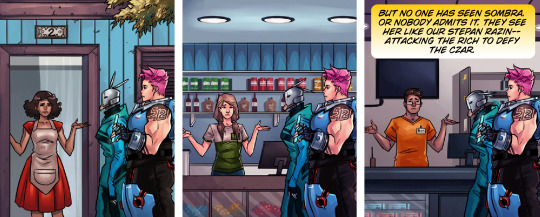
Edited sequence from the “Searching” comic where Zarya and Lynx-17 go door-to-door, showing everyone a photo of Sombra. Zarya’s internal dialogue in the last panel: “But no one has seen Sombra. Or nobody admits it. They see her like our Stepan Razin—attacking the rich to defy the czar.”
Sombra is (perhaps surprisingly) similar. As stated previously, she was brought in by a gang who billed themselves as seeking a justice for the Mexican underclass that they believed could not be achieved through legal means.
On her own? She holds to those ideals and that goal. She attacks and exposes the CEO of LumériCo, creating an opening to see some justice done for the Mexican people. (The attempt failed, and Portero is reinstated, but that’s besides the point.) Her continuing interest in seeing the Viper Portero removed only makes sense if she continues to have a personal investment in seeing justice for the underclass of her country.
This leads to Sombra being seen as an extrajudicial force of change and good by the Mexican people, particularly those in the Castillo and Dorado region. Zarya compares her to Stepan Razin (Wikipedia), who as I understand it led force composed in part of peasants in uprising and, though he failed, was immortalized as a folklore hero.
Though her methods are different and her goals much more specific, her actions, at least in Mexico, are similarly driven by a search for justice that cannot be delivered by the law.
The Enemies of Talon
I don’t have a lot to say about this, and segadores-y-soldados has summarized it quite better than I have, but it’s important enough to get it’s own section. But, Sombra working against Talon actually puts her technically on the same side as Jesse is—even though Jesse as of “Train Hopper” doesn’t seem that interested in actually ending Talon’s activities or denying them what resources they want, only in preventing them from hurting and killing innocents. (Though, I doubt Jesse is going to remain in that mode for long.)
It is entirely possibly, maybe even likely, that Sombra is aiding Jesse somehow as well as aiding Jack and Ana. I linked a couple of segadores-y-soldados’ relevant posts earlier, but I’ll link them again: linked before, new link.
Miscellanea, Smaller Comparisons
Sombra is embraced by her old gang Los Muertos, even though she has broken ties with them for her safety, as evidenced by the gang’s enthusiastic and open support of her attacks on LumériCo. Deadlock openly rejects Jesse and is suggested to have a “shoot on sight” policy for him, as evidenced by the numerous photos of him accompanying rifles and his photo pinned to a dartboard; it’s possible that they resent him for having avoided prison and taking the presented opportunity to turn over a new leaf.
Even after leaving their respective gangs, both Jesse and Sombra still make use of variations on the gangs’ symbols in their personal iconographies. Sombra identifies herself through a simplified graphic calaveras. While in Blackwatch, Jesse openly displays his tattoo and wears a buckle of the Deadlock winged skull; after leaving Blackwatch, his prosthetic arm features plating shaped like a skull. (The iconography extends to the game’s UI also, with EMP represented by a calaveras and Deadeye with a skull.)
Both take somewhat similar relationships to Gabriel: Jesse is framed as a surrogate son and a right-hand, Sombra is framed as a young accomplice who takes a more familiar tack and a frequent trusted partner. They’re opinionated and vocal about it, unafraid to talk back to Gabriel and criticize his planning.
Further in the personality vein of things, they’re characterized as deeply confident in their abilities to the point of cockiness and overconfidence, and they can be accused (and have been, by Gabriel, though with dubious sincerity) of having too high an opinion of themselves. But despite the breeziness, they are highly competent, thorough, and conscientious, and although they may appear to have a lot of things to say about other people’s plans, they execute their own plans with precision and utmost gravity. Arguably, both are playing a bit of the fool to mask how sharp, observant, and cunning they really are.
#Jesse McCree#Sombra#Sombra Overwatch#Olivia Colomar#Overwatch#Anonymous#Gena plays Overwatch#I FINALLY FINISHED IT.#I apologize to you anon for taking three months but it's nearly 4k words and I was in a slump.#But I am always very happy to talk about things—especially if it's McCree related.#But Sombra and McCree are very interesting as paired characters.#I fear I've spent more time talking about Los Muertos and Deadlock than I have Sombra and McCree though.#But I am deeply interested in the social dynamics and context of Deadlock specifically and all that can be drawn out of the little we know#so I tend to let it get away from me when talking Deadlock.
159 notes
·
View notes
Text
Anora (Tv Tropes)
Armor-Piercing Question: Receives one from Teagan regarding her father. In her first appearance, no less.
Anora: “Teagan, my father is doing what is best.”
Teagan: “Did he also do what was best for your husband, Majesty?” (Anora flinches as though shot by an arrow.)
Arranged Marriage: It's mentioned that Cailan and Anora were betrothed from a very early age, on account of their fathers' friendship.
Beauty Equals Goodness: Averted. Although she's beautiful, and she does genuinely care about her country, she's also scheming and manipulative. She's nobody's supportive cheerleader; she will turn on anyone if necessary to further her goals, including Ilona.
Better the Devil You Know: Her supporters support her because she's a known quantity, whereas Alistair is new. Her one unwavering supporter, Ceorlic, says as much at the Gnawed Noble Tavern.
Bitch in Sheep's Clothing: She betrays Ilona twice to further her own goal. Despite this, however, Ilona holds no hard feelings towards Anora and even refuses to have her executed, even after the end of the blight.
Bookworm: Loghain mentioned that during her childhood, Anora spends a lot of time reading instead of playing with the other kids in Gwaren.
The Chessmaster: She's just as clever and manipulative as her father, if not moreso.
Chronic Backstabbing Disorder: Betrays her father to Ilona, and then betrays Ilona back to him. No matter what risks Ilona took for her sake, Anora cheerfully backstabs her at the Landsmeet. And of course while rescuing her, when Ilona lets Anora speak for herself to Ser Cauthrien, she immediately claims that Ilona and her companions were kidnapping her.
Daddy's Girl: The two most important things in her life are her country and her father, and she'll do what she must to protect both of them. If anyone else had tried what Loghain did, she'd have had them drawn and quartered within the hour.
Damsel in Distress: At a certain point in the story. Subverted, however, in that she was not actually in as much danger as she claims, and played this role to gain Ilona's sympathy. Double Subverted in that Arl Howe was not only willing to kill Anora, but seemingly eager to do so — the queen wasn't nearly as in control of the situation as either she or her father later claim.
Easily Forgiven: Despite being backstabbed by her twice and everything else, Ilona holds no hard feelings towards Anora and refuses to have her executed to prevent potentially rebellious nobles from allying with her. This is because Ilona knows that Anora is not entirely a bad person.
Expy: Her backstory is similar to that of Edith of Wessex (being the daughter of a man who rose through the ranks on merit and was married off to the king to cement his position) but, interestingly, if left to rule, she becomes much more similar to Harold Godwinson (a ruler in their own right, who hadn't a drop of royal blood but was the most qualified for the job, and much more politically savvy than their father). Considering the Godwinson family was wiped out by the Norman invasion, this can even be taken as a Take That! to the Orlesians. Not to mention her resemblance - in both appearance and personality - to a certain former Ukrainian Prime Minister...
Fantastic Racism: More subtle than most, but her handling of alienages shows the apple doesn't fall far from the tree when it comes to Mac Tirs in power governing elves. During King Cailan's reign, Queen Anora was in charge of infrastructure, but the story shows that the alienages are poorly managed, if not outright neglected by her.
God Save Us from the Queen!: Subverted as Anora can be very ruthless in the way she tries to maneuver herself into power.
Hair of Gold, Heart of Gold: Subverted. Anora plays the stereotype of the virtuous fair-haired princess for all it's worth, but while she's not outright evil, she's not exactly pure or innocent either.
Happily Married: To Fergus Cousland. She meets him during Alistair’s coronation and hits it off really well with him. He proposes to her during the celebration of Alistair and Ilona’s wedding and they themselves marry not long afterwards and have two sons together.
The High Queen: An interesting case. She has the image of a High Queen, but once you get to know her, she quickly proves herself to be a manipulative and power-hungry politician. That does not mean she is evil, however: she really wants the best for Ferelden and its people, it's just that she is convinced she needs to be in power to make that happen.
Hot Consort: To Cailan.
I Need a Freaking Drink: After the Noodle Incident with the giant:
Anora: “We're going to get a drink. A lot of drinks. Maybe all the drinks they have. Come on.”
Inspired by...: With her political maneuvering against rivals for the throne and patronage of education and the arts, she's pretty clearly based on a number of historical female rulers, particularly Elizabeth I of England and Catherine the Great of Russia.
In the Blood: Like her father, she seeks to protect Ferelden at all costs and believes that she and Loghain are the only two people capable of doing so.
Law of Inverse Fertility: Her inability to get pregnant and sire an heir by her thirtieth year has led to many rumors that she's possibly barren, while more superstitious nobles believe it's the Maker's punishment for having a commoner for a Queen.
This becomes averted after she bears two sons with her second husband, Fergus Cousland.
Like Father, Like Daughter: As a few characters and Word of God points out, the most important thing to remember about Anora is that "she is her father's daughter." She certainly inherited her cunning, ruthlessness, and overconfidence in her own abilities from him, as Alistair points out. (See Pride below.)
Missing Mom: Her mother passed away some time before the story.
Morality Pet: Loghain does love his daughter, though he doesn't show it often.
Noodle Incident: The World of Thedas reveals that when he was still a prince, Cailan and Anora disappeared for nine days to hunt a giant, and were later found with a Fereldan soldier in Crestwood, "drunk as dwarves, covered in bruises, cuts, and ash, and smelling strangely of cheese."
Anora: “We defeated the giant. Now, let's never speak of this again.”
Opportunistic Bastard: While she can be very nice and helpful to those whose goals align with hers, Anora will manipulate or backstab anyone so long as it allows her to remain in power and secure the physical safety of her father, Loghain.
Out-Gambitted: Ilona was able to win the support of the Landsmeet even without the high support of Anora. Double points for Ilona being the daughter of Teyrn Cousland: Teyrn's daughter square-off.
Pride: Like her father, Anora's main flaw is her overconfidence in her own abilities, and unwillingness to compromise her vision for Ferelden even to save her people.
Alistair: “She's her father's daughter. Me, I say that's where the problem lies. People like her and her father always think they're the only ones who can fix things, and everyone else should just stay out of their way.”
Puppet Queen: As Loghain's tyranny becomes progressively worse over the course of the game's events, many people feel Anora to be this, considering she is the Queen and yet is doing nothing to rein in her father's excesses.
Romancing the Widow: This applies to both her and Fergus Cousland when they started a romantic relationship and married. Anora’s husband, Cailan was killed during the battle of Ostagar and Fergus’s wife and son were slain when Arl Howe invaded Castle Cousland.
Ungrateful Bastard: No matter what route Ilona took in rescuing her from Arl Howe, she has shades of this.
When Ilona reveals her to Ser Cauthrien, she immediately claims Ilona and her companions were kidnapping her instead, before fleeing the battle.
When she demands an attempt to rescue Ilona, when Eamon mentions that they need to rescue Alistair as well, she makes it perfectly clear to everyone that she wants only Ilona to be rescued, preferring to let Alistair simply rot in Fort Drakon to eliminate the threat he poses to her continued reign. Queen or not, Arl Eamon makes it very clear that he's not amused.
The Woman Wearing the Queenly Mask: Played with. Anora likes to pretend that she's this, but one gets the impression that the mask is her true personality. According to everyone in Thedas, she was running the country's infrastructure while Cailan led the armed forces.
0 notes